Model Shipways
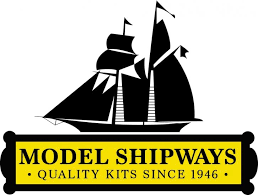 |
Speciale kits ontworpen en gemaakt in de VS. Model Shipways produceert sinds 1946 houten scheepsmodelbouwpakketten en staat bekend om het gebruik van hoogwaardige materialen, nauwkeurig gesneden onderdelen en duidelijk geschreven, zeer gedetailleerde instructies en plannen. |
| Naam | Omschrijving | Afbeelding |
|---|---|---|
| Armed Virginia Sloop, American Privateer | Privateers were privately owned vessels whose owners were commissioned by the government to carry on naval warfare. Privateering is not considered piracy, which is performed without government authorization. During the 18th century, many small single masted ships were armed and used for privateering. These Chesapeake-built vessels were fast and easily maneuverable with a graceful sheer and a low freeboard. They evolved from the Bermuda sloops of c. 1740 and the trim, sharp Virginia schooners found in Steel’s Naval Architecture of 1805. Model Shipways’ kit is based on a drawing found by nautical historian Howard I. Chapelle in European archives and reconstructed by John F. Millar, author of Early American Ships. Our exciting new kit, Armed Virginia Sloop from Model Shipways has all the accuracy and detail seasoned modelers crave, yet it's easy enough for a novice to build. Double plank-on-bulkhead construction uses laser cut basswood and walnut parts and planking strips. Britannia metal castings and a host of brass, copper and wooden parts duplicate deck hardware and accessories. Six cannon and eight swivel guns serve as armament. Beech mast, yards and boom, over 200 yards of rigging line in four diameters, plus a variety of walnut deadeyes and blocks assure scale accuracy. Hardwood stock for launching ways is also included. Seven sheets of meticulously drawn plans and a 40 page step-by-step instruction manual help you create a true museum quality replica of Model Shipways' Armed Virginia Sloop. Model Shipways' Armed Virginia Sloop Kit Features • Authentic plank-on-bulkhead construction • High quality basswood planking strips • True-to-scale Britannia metal, brass and hardwood fittings • Six Britannia metal cannon & eight swivel guns • Over 130 hundred yards of rigging line in four diameters • Seven sheets of detailed plans and 40 page step-by-step instruction manual Plank on Frame Construction Length: 788mm Height: 559mm Scale 1:64 | 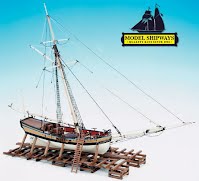 |
| Benjamin Latham | The Benjamin W. Latham is an outstanding example of a turn-of-the-century Grand Banks fisherman. Built in the Tarr & James yard at Essex, MA in 1902, she sailed out of Noank, CT as a mackerel steiner. From 1906 to the end of her career, she operated as a dory trawler out of New York's Fulton Fish Market. She was lost off the coast of San Juan in 1943. Our own Model Shipways Benjamin W. Latham model is a joy to build, and the large, 1/4 scale allows for lots of detail. All wooden parts, including the false keel and 14-piece bulkhead set, are laser cut. The Ben Latham kit contains basswood planking for the hull and deck, and plenty of strip stock for timberheads, monkey boards, riding bitts and deck pads. Basswood is also supplied for deck cabins, hatches and chain boxes. Wooden blocks and deadeyes number over 100, and rigging comes in three diameters. You'll find brass eyebolts, chainplates and strop rings. The Britannia metal fitting set is one of the most comprehensive we've ever compiled, including windlass parts, anchors, bilge pumps, props, exhaust pipes, fiferails and smokeheads. One of the most remarkable features of our Model Shipways Benjamin W. Latham is an authentic plank-on-bulkhead seine boat. You'll build it upside down on a set of formers, just like the real thing! Sail cloth for a full complement of sail completes the kit. Smithsonian Institute, supplement original plans by Erik A. R. Ronnberg, Jr., for a total of six sheets. Updated 48 page instruction book leaves no construction detail unexplained. (Display base with pedestals not included.) Plank on Frame Construction Length: 838mm Height: 686mm Scale 1:48 | 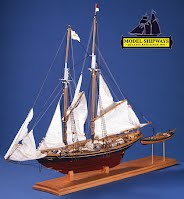 |
| Bluenose, Canadian Fishing Schooner | The schooner Bluenose was built in Nova Scotia in 1921 to fish the rough waters off the coast of Newfoundland. A salt banker type, she stayed out until her holds were full, using salt to preserve the catch. Bluenose was lost on a reef near Haiti in 1946, but an exact replica was launched in 1963. Model Shipways' kit is the most authentic representation of any Bluenose available. And now, thanks to newly drawn plans and revised instruction book by Ben Lankford, it's ever more accurate and easier to build. Plank-on-bulkhead construction uses laser cut basswood parts for a perfect fit. Flexible basswood strips are supplied for planking the hull. Fittings are true to the originals, and include wooden blocks and deadeyes, Brass ring and eyebolts, plus Britannia metal bilge pump, fife rail and anchors. Three diameters of rigging line and cotton sailcloth ensure an impressive model. (Display base with brass pedestals not included.) Plank on Frame Construction Length: 813mm Height: 673mm Scale 1:64 | 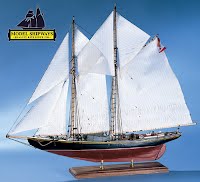 |
| Chaperon, Sternwheel Steam Packet 1884 | The steam packet Chaperon was built for trade traffic at Chambersburg, Ohio in 1884. At that time river shipping was inexpensive. A bushel of coal was carried from Pittsburgh to New Orleans for the price of a first class postage stamp. But, the Ohio River was shallow during the summer and often choked by ice in the winter. This made steamboat travel seasonal and delays frequent. In 1906, the U.S. Army Corps of Engineers built the Green River Lock and Dam 6, just downstream from Kentucky’s Mammoth Cave. Chaperon was the first boat of its kind to pass through the new locks. In addition to hauling cargo, she ran sightseeing excursions between Bowling Green and Mammoth Cave during the summer months. Sold just before WWI, Chaperon sailed the Tallahatchie River until fire destroyed her in 1922. The model you’ll build from Model Shipways’ kit will be a historically accurate and perfectly scaled replica almost three feet long. An amazing number of laser-cut basswood and limewood parts make up the hull, superstructure, paddlewheel, gangplank and railings. A photo-etched brass sheet provides incredible ornamental detail. Other brass parts include bell, eyebolts, cleats and nails. Ready-to-use Britannia metal lifeboat, lanterns, capstan and whistle, hardwood blocks and three diameters of rigging line add life-like authenticity. Six sheets of plans and clear assembly instructions pave the way to a magnificent model. Plank on Frame Construction Length 877mm Beam 190mm Height: 300mm Scale 1:48 | 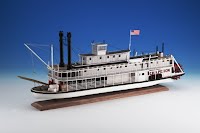 |
| Charles W Morgan, Whaling Bark | During her 80 years and 37 voyages, the Charles W. Morgan caught and processed more whales than any other whaling ship in history. Built in 1841 at the Hillman Brothers Shipyard on the Accent River in New Bedford, MA, she was registered at 351 tons. The Morgan was originally built fully ship-rigged, but shortly after the Civil War she was modified to become a double topsail bark. Her whaling days came to end in 1921 with the decline of whale oil prices. Purchased for Mystic Seaport in 1941, she's now a beautifully restored monument to the men who built and sailed her. Designed by naval architect Ben Lankford, our Model Shipways' kit replicates the Charles W. Morgan as a double topsail bark of 1892-1908. Lankford's precise drawings (a set of six) are based on plans for the 1983 restoration, provided by Mystic Seaport. A 40 page step-by-step instruction book includes many of the author's own photographs of the reconstructed vessel. Plank-on-bulkhead construction of the Charles W. Morgan by Model Shipways uses laser cut basswood for the hull components. Wooden bow and stern filler blocks help you shape the real ship. We supply 75 feet of copper sheathing to cover the hull below the waterline. Wooden yards and mast, 140 deadeyes in three sizes, nearly 200 single and double blocks, four diameters of black running rigging and two of white standing rigging duplicate the rig plan of the original whaler. An assortment of fine metal fitting includes brass ship's bell, belaying pins, eyebolts, spilt rings, strips, wire and chain, anchors, bilge pump, chocks, cleats, fire door, chimney, and galley stack. Seven whaleboats, to be assembled from laser cut wooden parts, come complete with authentic scale whaling gear. (Display base and pedestals not included.) Plank on Frame Construction Length: 781mm Height: 635mm Scale 1:64 | 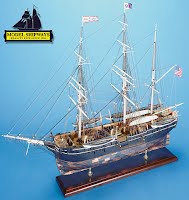 |
| Emma C. Berry, Lobster Smack | The Emma C. Berry was built in Noank, Connecticut in 1866. This type of vessel was known as a “Noank Smack”. Smacks like the Emma C. Berry contain a live well, which is a watertight structure built inside the vessel. Within the well, numerous holes drilled in the bottom of the boat allowed fresh (oxygenated) seawater to circulate through. This way, live fish and lobsters could be transported from the fishing grounds to market. The Emma C. Berry is the last existing representative of her type. Model Shipways is proud to present the Emma C. Berry 1:32 scale ship model kit. In keeping with her original design, the Emma C. Berry kit is a true plank-on-frame model, using beech and basswood for strips and beams. The keel and ribs are just some of the parts that have been laser-cut, making for easier construction. Deadeyes and blocks are made out of walnut. As a sloop rigged vessel with a large mainsail, two headsails and a gaff topsail, the Berry kit also contains over 50 yards of black and gray (standing & running) rigging line. This would have been used to support and manipulate her double head sail gaff sloop rig. Model Shipways' kit is based on drawings and documentation provided by the Henry B. DuPont Preservation Shipyard at Mystic Seaport. The kit offers true plank-on-frame construction with the same number of true-to scale frames as the original. The frames are erected with the hull upright, just like a real ship. Although a bit more difficult than building a upside down, this permits the addition of many inboard details. Model Shipways kit contains laser cut wooden parts, basswood hull planking strips and wood stock for launching ways. A host of finely cast Britannia metal fittings and anchor shank. Brass is used for eyebolts, rings, chain and wire. Walnut blocks and deadeyes come in five sizes, and 50 yards of black and gray line are provided for accurate rigging. Four sheets of plans and 40 page instruction manual by kit designer and naval architect Ben Lankford record every detail of construction. Plank on Frame Construction Length: 680mm Height: 724mm Scale 1:32 | 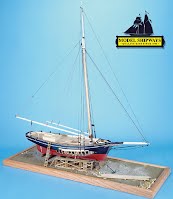 |
| Fair American, 14-Gun Privateer, 1778 | Model Shipways' Fair American is a reproduction of a model built over 200 years ago, now on exhibit at the U.S. Naval Academy Museum at Annapolis, MD. She is said to represent the 14-gun privateer Fair American sailing out of Charleston in 1778. Plank-on-bulkhead construction uses high quality basswood, the preferred wood of professional modelers. All structural hull parts and major fittings are laser cut, so they fit together with remarkable ease. Model Shipways’ Fair American kit contains over 60 cut or shaped wooden parts, plus 120 extra wood strips for a second layer of planking, should you wish to build your model with a double planked hull. More than 500 fittings of wood, brass and Britannia metal fittings include 14 brass guns on wooden carriages, cannon, chainplates, bell, anchors and wheel. Six plan sheets a 48 page instruction book by Erik A.R. Ronnberg, Jr. and Ben Lankford, plus a 38-page guide to planking the hull make building easy. (Display base and brass pedestals are not included.) Plank on Frame Construction Length: 674mm Height: 559mm Scale 1:48 | 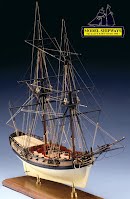 |
| Flying Fish | Donald McKay, one of the greatest designers of his time, built the Flying Fish in 1851 at East Boston Massachusetts. Flying Fish was registered at the Boston Custom House as a ship of 1,505 tons, with a hull length of 207 feet, and a beam of 22 feet, and a beam of 22 feet. She sailed from New York to San Francisco in 92 days - only three days short of the record set by her sister ship, the Flying Cloud. Plank-on-bulkhead construction by Model Shipways features laser cut basswood keel and 21-piece bulkhead set. Stem, sternest, rudder, stern pieces and planksheer are also laser cut. The hull is planked with individual basswood strips, and we supply self-adhesive copper coil to sheath it below the waterline. Masts, yards and spars are high quality beech. Rigging plan is faithful to the original, with three diameters each of black standing and white running rigging, plus 200 wooden deadeyes and 225 blocks in various sizes. Eyebolts, backing links and ship's bell are solid brass. We reproduce virtually every detail of the real clipper ship, and expertly cast Britannia metal fittings ensure scale accuracy. You'll find figurehead, anchors, five ship's boats, capstans, binnacle, mast caps, windows and ladders, chocks, davits and stanchions, even the cabin stove! Six sheets of beautifully drawn plans and 56 page step-by-step instruction manual by noted naval architect, Ben Lankford, assure trouble-free completion of a magnificent replica. (Display base and brass pedestals not included.) Plank on Frame Construction Length: 914mm Height: 572mm Scale 1:96 | 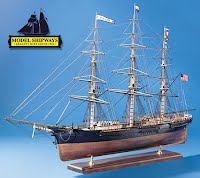 |
| Glad Tidings Pinky Schooner | Originating in 16th century Europe, the Pinky received its name from its uplifted, narrow, or “pinked” stern. These sturdy, seaworthy craft ruled the New England fishing industry from 1815 to 1840. They were gradually replaced by the larger, faster Gloucester schooners. Because of their stability and grace, many pinky schooners were built as pleasure boats in the late 1900’s. Model Shipways’ Glad Tidings plans are based on original drawings by Howard I. Chapelle for a typical Maine pinky, a boat he had built and actually sailed. Launched in 1937, Chapelle’s Glad Tidings was a two-masted schooner with a gaff rigged fore and aft mainsail, and single jib. Our Glad Tidings contains features never before seen on any commercially available kit. We’ve laser cut the bulwark strakes, and our plans show the spiling and placement of the hull planking strips to exact dimension. Single plank-on-bulkhead construction uses laser cut plywood, basswood and cherry components. Expertly cast Britannia metal castings include anchor shanks, smoke stacks, windlass, cabin port-lights and turnbuckles. Brass is used for eyebolts, split rings, nail and other fittings. Keel, stem, hull and deck planking strips, dowels for masts and yards are fine basswood. Six diameters of beige standing and black running rigging, deadeyes and four sizes of blocks guarantee a realistic replica. Five sheets of detailed plans and illustrated step-by-step instruction manual assure trouble-free assembly. (Display base and pedestals are not included.) Plank on Frame Construction Length: 749mm Height: 584mm Scale 1:24 | 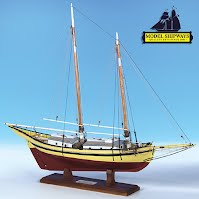 |
| Harriet Lane, US Civil War Gunboat | Built in New York for the U.S. Revenue Service in 1857, the Harriet Lane was powered by a combination of steam and sail. She was 180 ft. long, with a 30 ft. beam, and carried a 30 lb. Parrott rifle, plus three 9" smooth-bore Dahlgrens. Her design clearly illustrates the transition from sail to steam, as steam engines were not entirely reliable, and power was not yet sufficient to allow the elimination of sail. Model Shipways Harriet Lane features a machine carved hardwood hull which needs only light shaping and sanding. We provide plank-scored basswood for decking and cabins, spars and hardwood blocks. Ladders, anchors, paddle wheels, two ship's boats, four cannon with carriages and numerous other fittings are finely cast Britannia metal. We’ve upgraded the kit to include laser cut paddle wheel covers. Model Shipways includes detailed plans and newly written clear instructions by master ship modeler, Ben Lankford, are easy to follow. (Baseboard and brass pedestals are not included.) Solid Hull Construction Length: 496mm Height: 241mm Scale 3/32 = 1 ft. | 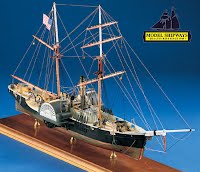 |
| HMS Bounty Launch | As captain of the HMS Bounty, William Bligh demonstrated an obsession with paltry matters. Too hastily provoked, he antagonized officers and crew with frequent and uncontrolled outbursts. With tempers already flaring and resentment simmering, a trivial matter of coconuts stolen from the ship’s store provoked a true mutiny. On April 28, 1789, Fletcher Christian and his sympathizers took over the ship, casting Bligh and 18 of his loyal supporters adrift in the Bounty’s 23’ launch. In a remarkable feat of seamanship, Bligh navigated the dangerously overcrowded boat on a 47-day voyage to the Dutch colony of Timor, equipped only with a sextant and a pocket watch. He recorded the distance as 3,618 nautical miles. While struggling to survive, he kept a log and produced highly accurate charts and surveys of the seas and the terrain, such as the Fijian Islands and the northeast coast of Australia. The Bounty’s launch was typical of boats issued to Royal Navy ships of the period. Historically accurate and highly detailed, Model Shipways’ HMS Bounty’s Launch kit is based on original plans from the Nautical Maritime Museum in Greenwich, England. It features true plank-on-frame construction with laser cut wooden components, laser engraved rabbet and bearding lines. Beautiful cherry wood is provided for the frames and deck beams. Hull and quarterdeck planking, floorboards and mold stiffeners are flexible basswood. The fitting package replicates authentic gear, including ten oars, eight lathe turned wooden barrels, wooden chest, cast metal anchor, brass gudgeons and pintles, plus cotton sails and cordage. Five sheets of plans and illustrated instruction manual assure trouble-free assembly. Plank on Frame Construction Length: 438mm Height: 375mm Beam: 130mm Scale 1:16 | 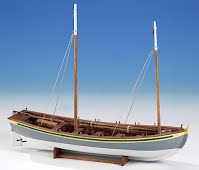 |
| Mayflower, 1620 | On September 16, 1620, The Mayflower set out from Plymouth, England. Bound for Virginia to establish a permanent colony in North America, she carried 102 men, women and children. Many of the passengers were Separatists fleeing religious persecution in Europe. After two months at sea, the ship dropped anchor at what is now Provincetown, MA. It was almost 200 miles farther north than planned, but winter was approaching, so the Pilgrims decided to stay. Half of the colony did not survive that first winter, but the rest lived on and prospered. Historians have tried to identify the Mayflower, but all that’s certain is that she was a wine-ship of 180 tons of the type commonly used during the early 17th century. In 1957 a British group sponsored the voyage of a replica from Plymouth, England to Plymouth, MA. The vessel was given to the United States as an expression of international goodwill and remains on exhibit at Plymouth, MA. Model Shipways’ kit is a re-make of the very popular Mayflower manufactured by Model Shipways in the late 1950s. We've converted the old solid hull kit to plank-on-bulkhead construction. All other wooden components have been laser cut. A generous fittings package contains ready-to-use hardwood blocks and deadeyes, precision cast Britannia metal and brass detail parts and five diameters of rigging line. Detailed plans and illustrated assembly instructions make building easy. Hardwood display base and pedestals are also included. Plank on Frame Construction Length: 560mm Height: 432mm Scale 1:64 | 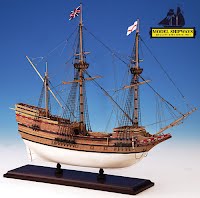 |
| Miss Adventure, Flyer Class Mahogany Racing Boat | Model Shipways Miss Adventure kit reproduces every feature of a flyer class mahogany racing boat in authentic detail. You'll assemble your model according to the plank-on-frame construction methods used on the original boats. Laser cut basswood parts make building easy. High quality mahogany planking strips provide a beautiful finish. Photo-etched instrument panel and perfectly scaled nickel plated Britannia metal fittings add life-like detail. Abundantly detailed as a fine display model, Model Shipways Miss Adventure was designed for fast cruising. We include a powerful Mabushi RS-540 electric motor and all necessary R/C running hardware - propeller, rudder, brass shaft and tube, coupler, and steering pushrod. Clear plans and a step-by-step instruction manual take you to a beautiful finish. Includes laser-cut display stand. Can be built as a Radio control model or Static Display kit Plank on Frame Construction Length: 686mm Height: 114mm Beam: 247mm Scale 1:16 | 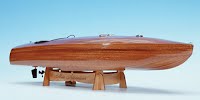 |
| New Bedford Whaleboat 1850-1870 | From 1720 to 1920 nearly 60,000 whaleboats were consumed by the American whaling industry. With a useful life of no more than three years, whaleboats were discarded on the spot throughout the coastal U.S. and around the world. Remarkably, only a dozen or two have survived to become part of today's museum collections. In 1916, the Dartmouth Historical Society commissioned the building of a half sized model of the bark LAGODA. Local whaleboat builder Joshua Delano was retained to build the seven half-sized model whaleboats needed for the project. Delano built these models according to the design of the full-sized boats he had built for the whaling industry for more than forty years. Whaling historian Erik A.R. Ronnberg, Jr. made a thorough study of Delano’s half-sized boats in order to produce this kit of a uniquely American working craft. You'll follow the original plank-on-frame method of construction in building your Model Shipways kit. Hull planks, oar and paddle blades, tubs, casks and rudder are accurately laser cut basswood. Authentic scale whaling gear gives this kit remarkable detail. Photo-etched copper fittings include harpoon, lance and cutting spade heads, knife blades, oarlocks and mast hinge hardware. KIT FEATURES • Authentic plank-on-frame construction duplicates original construction techniques • Laser cut basswood components • Photo-etched copper fittings include harpoon, lance and cutting spade heads, knife blades, oarlocks and mast hinge hardware • Cast Britannia compass bowl and bomb lance gun • Sailcloth & three diameters rigging line • Six sheets of precise, highly detailed plans • 150-page illustrated instruction book Our Model Shipways New Bedord Whaleboat kit is supported by a superb set (6 sheets) of plans and a 150 page instruction book by Erik A.R. Ronnberg, Jr. The book, To Build a Whaleboat, gives you step-by-step building instructions, design and technical data. (Display base and pedestals not included.) Plank on Frame Construction Length: 610mm Height: 119mm Scale 1:16 | 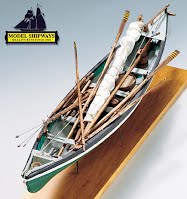 |
| Niagara, US Brig 1813 | Commodore Oliver Hazard Perry took command of the American naval forces at Lake Erie in the spring of 1813. The famous battle with the British fleet began on September 10, when Perry raised a flag bearing the words “Don’t Give Up The Ship” and sailed into action. After three hours of murderous gunfire, Perry was forced to abandon his flagship, the Lawrence. In a daring move, he was rowed a half mile to the Niagara, from which he continued the attack. After the battle, Perry returned to the shattered Lawrence and penned a quick message to General Harrison, “We have met the enemy and they are ours.” This decisive victory at the Battle of Lake Erie ensured American control of the Great Lakes during the War of 1812. Reconstruction of the brig Niagara was completed in 1990. Operated by the Pennsylvania Historical and Museum Commission, she is the centerpiece of a new maritime museum in Erie, PA and serves as the Commonwealth’s goodwill ambassador. Model Shipways' Niagara kit is a faithful representation of the reconstructed Niagara at the maritime museum in Erie, PA. Model design is based on research and plans for the 1990 reconstruction, provided by Melbourne Smith of the International Historical Watercraft Society in Annapolis MD. Laser cut basswood parts facilitate plank-on-bulkhead construction. Individual basswood strips cover the hull, and we provide six filler blocks in our Model Shipways Niagara to make the job easier. True-to-scale Britannia metal, brass an hardwood fittings assure scale accuracy. Eighteen cast metal carronades and two long guns duplicate the armament of the original vessel. Rigging material include over 600 blocks and deadeyes and four diameters of rigging line. Six sheets of detailed plans and 40 page illustrated instruction manual by Ben Lankford clarify every phase of construction. (Display base and brass pedestals not included.) Model Shipways' Kit Features: Authentic plank-on-bulkhead construction, Laser cut basswood structural parts, True-to-scale Britannia metal, brass and hardwood fittings, Eighteen carronades and two long guns, Four diameters of rigging line, Six sheets of detailed plans and 40 page step-by-step instruction manual Plank on Frame Construction Length: 927mm Height: 622mm Scale 1:64 | 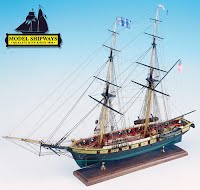 |
| Pride of Baltimore | Virginia-built schooners first appeared during the American Revolution. Known as Baltimore Clippers, they helped establish the Port of Baltimore as a major shipbuilding center. Many were used as privateers during the War of 1812. Sleek, light, and exceptionally fast, they could overtake and seize the enemy with ease, destroying British shipping and earning huge profits for their owners. In 1974, Baltimore city officials decided to build a replica of a 19th century clipper to serve as good-will ambassador for the city. The ship, named Pride of Baltimore, was launched at Baltimore's Inner Harbor on February 27, 1977. She was lost in micro-squall (an intense blast of wind building to hurricane velocity within seconds) on May 14, 1986. The city then commissioned a larger sister-ship, and the Pride of Baltimore II was launched on April 30, 1989. Designed by naval architect Ben Lankford from original plans, our Model Shipways Pride of Baltimore kit is an accurate representation. Ease of assembly and quality of components are two of the important attributes of the model. Structural parts, such as keel and bulkheads, are fine basswood, the choice of professional model builders. All wooden parts, from keel to sternpost, are laser cut for a perfect fit. Many of the Britannia metal castings have been designed specifically for this model, and include windlass life rings, vents, propellers, anchors, wheel, bilge pumps, and swivel guns. Ship's bell, portlights, eyebolts and cannon barrels are brass. 150 wooden blocks and deadeyes, and four sizes of cotton line duplicate the rig plans and 48 page illustrated instruction manual guarantee smooth sailing. You'll display your finished Pride of Baltimore model on wooden launching ways, also included with the kit. (Display base is not included.) Plank on Frame Construction Length: 813mm Height: 572mm Scale 1:64 | 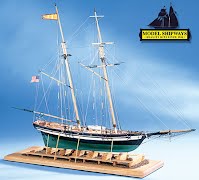 |
| Prince de Neufchatel, American Privateer | One of the most distinguished of the American privateers of the War of 1812, Prince de Neufchatel was built by Christian Bergh at New York in 1812-13. A superbly built brigantine of 310 tons, she measured 107' 6" at the waterline. She carried sixteen 12-pound carronades and two long 18's as chase guns. Captained by J. Ordonaux of New York, she sailed with a crew of 150 men. Prince de Neufchatel ’s most stunning battle took place on October 11, 1814, as she sailed with 37 prisoners and $300,000 in goods after a very successful cruise. Most of her crew had been sent to man the prizes she had captured, with only 40 remaining on board. The British frigate Endymion sighted and pursued her, dispatching 111 men in 5 boats. Neufchatel opened fire, but the boats were soon alongside, and the British clamored aboard. A desperate battle ensued. Seven Americans were killed and 24 wounded, with only 9 men left untouched. The British lost the fight with 28 killed, 37 wounded and 10 taken prisoner. Model Shipways' Prince de Neufchatel uses high quality basswood for internal frame-work. Our own laser machine cuts all wooden parts to absolute perfection. Single-piece keel and deck planking are basswood, and 22 bulkheads are high quality 1/8" plywood. Stem, rudder windlass supports, gun carriages and mastcap are walnut. The hull is planked twice; flexible basswood strips are covered with a layer of rich walnut. We include extra walnut strips for channels and railings. Perfectly scaled fittings include two sizes of wooden deadeyes and six sizes of walnut single and double blocks. Black standing and gray running rigging is provided in four diameters each. Britannia metal fittings are plentiful and accurately detailed, and include galley stack and two-horned cleats. Sixteen turned brass carronades were designed specifically for the Prince. Brass is also used for rudder, spar bands, pumps, and eyebolts. Gunport lid hinges are copper. Five sheets of plans leave no detail unrecorded, and 32 page illustrated instruction manual is easy to follow. Basswood launching ways complete the kit. (Display base is not included) Plank on Frame Construction Length: 826mm Height: 584mm Scale 1:64 | 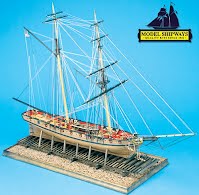 |
| Rattlesnake, American Privateer 1780 | The privateer Rattlesnake was built at Plymouth, Massachusetts in 1780. Despite her moderate size of 89 feet on deck, she was fast and weatherly. She sailed with 85 men and carried twenty 6-pounders. She captured over a million dollars worth of British goods on her first cruise, establishing a reputation as a formidable vessel. The British ordered her captured at any cost. She was seized by the 44-gun H.M.S. Assurance in 1783, sent to England and taken into the Royal Navy. She was sold out of service in 176. One of the mainstays of the Model Shipways line, Rattlesnake features plank-on-bulkhead construction with laser cut basswood components and lead-free Britannia metal castings. Brass fittings include eyebolts, and rings, wire and strip material. Your finished Model Shipways kit will be an authentic replica, with four sizes each of gray running and black standing rigging, 110 wooden deadeyes and over 200 blocks. Four sheets of plans (two by George F. Campbell outlining hull details and rig plan, plus two by Ben Lankford showing plank-on-bulkhead hull construction) and a comprehensive 48 page illustrated instruction book guide you to a memorable Rattlesnake model. (Display base & brass pedestals not included.) Plank on Frame Construction Length: 711mm (28") Height: 457mm (18") Scale 1:64 | 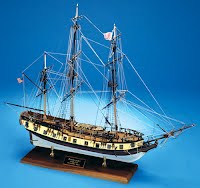 |
| Speakeasy, Prohibition Era Rumrunner | With the passage of the Volstead act in 1919 and the ratification of the 18th amendment in 1920 America went dry. Thus began the era of prohibition in America which lasted 13 years until the 18th amendment was repealed in 1933. Those 13 years were a tumultuous period in American life. The seemingly unquenchable thirst for alcohol led to some of the most brazen flaunting of the law in American history. From remote backwoods distilleries, the establishment of the speakeasy saloons, the infamous gang wars of Chicago and other cities, to bathtub gin, Americans found a way to get their booze. A large part of the illicit trade in whiskey, wine and beer was the smuggling into the U.S. from Canada and from ships anchored offshore outside of the jurisdictional limits of the law. So much money was to be made from smuggling that fishermen and boatmen of both coasts found smuggling irresistible. They applied their expertise at boatbuilding and boat handling to this lucrative albeit illegal trade. Fast boats were needed which could carry tons of cargo and be swift and nimble enough to elude the law. To this end a number of fast utility boats were designed and built using the most powerful engines of the day. During World War One the liberty aircraft engine was developed and at wars end over 20,000 had been produced. Generating over 400 horsepower and readily available as war surplus, this engine found its way into many of these fast boats. At the time the Coast Guard had nothing so powerful and fast and the so called “rumrunners” could easily evade the law. In time the authorities contracted their own fast chasers and a struggle for supremacy on the seas continued until the end of prohibition. Our model is based on a design developed in 1921 for a 36’ launch. It was designed around a 450 horsepower V-12 Liberty engine. The scale of the model is 3/4” to the foot (1:16) resulting in a model of 27” in length, well suited for RC operation. The model is completely CAD designed ensuring accurate fitting of parts. A plank on frame design it is completely constructed of basswood with cast fittings, brass for the rudder fittings, and a spoked steering wheel. A powerful electric motor, stern tube, propeller shaft and propeller are included. Plank on Frame Construction Length: 686mm Beam: 168mm Scale 1:16 |  |
| Sultana | Sultana by Model Shipways - Solid Hull Kit Built by Benjamin Hollowell in Boston in 1767, Sultana was seaworthy far beyond her size of 51 feet. The Royal Navy bought her in 1768, and she became one of Britain's most effective weapons in the fight against smugglers. One of our most popular kits, the Model Shipways Sultana features a machine carved basswood hull that requires only light shaping and sanding. Other wooden parts, including the 2-1/8" ship's boat, are laser cut for a perfect fit. Plank-scored decking, spars, wood materials and eight cast metal swivel guns are all included. For historical accuracy, original rigging is duplicated with cotton cordage and 67 wooden blocks. Detailed plans by Ben Lankford and a 24 page instruction manual help you build an authentic replica. (Display base and brass pedestals are not included.) Solid Hull Construction Length: 432mm Height: 381mm Scale 1:64 | 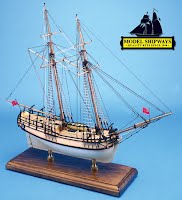 |
| USS Constitution 1797 | Model Shipways is proud to produce the best and most accurate USS Constitution available. Our kit is based on the 1927 Navy drawings, photographs and documentation used during the 1993-97 restoration. It is so complete and highly detailed that shipping weight is an incredible 12 pounds! Plank-on-bulkhead construction features laser cut wooden parts. High quality basswood planking strips cover the hull and we include self-adhesive copper tape for hull plating. True-to-scale Britannia metal, brass and hardwood fittings and 16 photo-etched brass sheets provide life-like detail. Over 50 cannon, carronade and gun barrels duplicate original armament. Extra touches include laser cut gratings and engraved scrollwork. Four-hundred yards of rigging line in six diameters is also supplied. Model Shipways kit includes eight sheets of detailed plans and 48 page step-by-step instruction manual by Ben Lankford uncover the secrets of building a museum quality replica. (Display base and pedestals not included.) Launched on October 21, 1797, the USS Constitution has won every battle she's ever fought - over 40 of them! She earned her nickname “Old Ironsides” after a sailor saw a cannonball bounce off her hull. Resting in Boston Harbor, she's the oldest commissioned US warship. USS Constitution went through several restorations during her career. A major restoration between 1993 and 1997 prepared the frigate for her 200th anniversary. Workers restored the thick deck strakes and diagonal riders to strengthen the hull and make her seaworthy. They fitted fore, main and mizzen topsails, jib, flying jib, and spanker sails for the day when "Old Ironsides" would move under her own power once more. That historic moment arrived on July 21, 1997, when Constitution set sail from Marblehead Harbor to a point just one mile short of Halfway Rock. The five-mile cruise took one hour. Plank on Frame Construction Length 1219mm Width 406mm Height: 812mm Scale 1:76.8 | 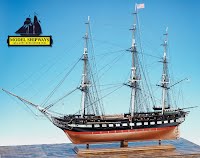 |
| Willie Bennett, Chesapeake Bay Skipjack | The skipjack was the last type of sailing vessel developed on Chesapeake Bay for commercial operation. Evolved during the 1880’s from various local types of flat and V-bottom skiffs and boats, the skipjack is still used today to harvest the Bay oyster. The Willie L. Bennett was built in 1899 at Inverness, Maryland. Her lines were recorded at Cambridge, Maryland by naval historian Howard Chapelle in 1942. Her whereabouts were unknown from 1942 until 1954, when she was discovered sunken in Harris Creek, Tilghman Island off Maryland’s Eastern Shore. After she was raised and surveyed, it was determined that the damage was too expensive to repair. She was then returned to her resting place, where traces of her remains may still be found. Model Shipways Willie L. Bennett kit is based on the craft discovered in 1954. You'll build your model the way the real Willie L. Bennett was built, following the plank-on-frame techniques used on life-sized skip-jacks. To make building easy, we've supplied laser cut wooden molds, keelson and transom. Basswood is used throughout. Outfit your craft with cast Britannia metal anchor, ship's wheel and deck machinery. Deadeyes and deck machinery. Deadeyes and blocks are wood, and there's plenty of brass for eyes, hoops, rings and chain. Sail cloth and rigging line complete your model. The 56 page instruction book by Ben Lankford gives you a wealth of detail with lots of photographs and drawings. Model Shipways provides three sheets of plans that are so accurate that you could almost build a real skipjack using them! (Display base and pedestals not included.) Plank on Frame Construction Length: 610mm Height: 406mm Scale 1:32 | 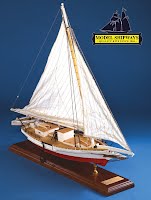 |





